Everything You Need to Know About Pests and Gardening
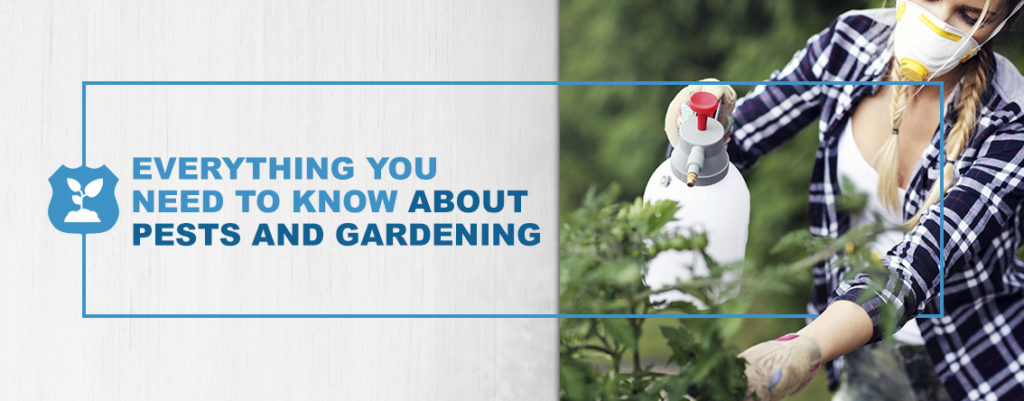
Gardens are a perfect way to beautify your yard and grow your own produce. Some studies even suggest gardening is a physically, mentally and emotionally beneficial way to pass the time. Unfortunately, pests can latch on to your garden plants and cause an array of problems. Whether you’re a novice or expert gardener, an understanding of common invading pests — as well as which plants attract and repel them — can help you protect your garden.
How Pests Can Cause Damage
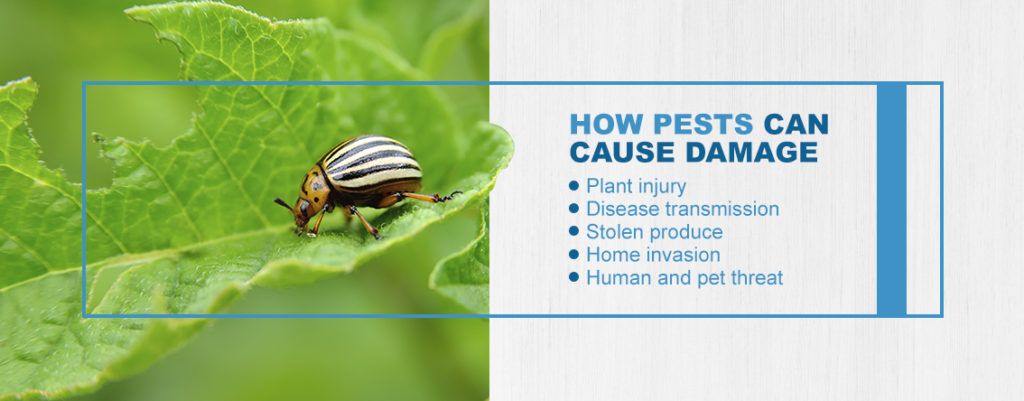
The type of damage a pest inflicts depends on the pest itself. For example, chewing insects are responsible for the tiny holes and markings you may find on plant leaves, and piercing insects tend to suck sap and nutrients from a plant, causing discoloration or wilting.
These are a few ways pests can damage your garden:
- Plant injury: Bugs and wildlife chew on different parts of plants, which can cause discoloration, wilting, holes, displaced roots, leaf curling, stunted growth, misshapen fruits or vegetables, browning or decay.
- Disease transmission: Harmful insects can accidentally, passively or actively pass pathogens to your plants, which leads to plant disease. Insects who do this are known as vectors.
- Stolen produce: Large pests like wildlife can quickly pillage and consume planted bulbs and ready-to-harvest fruits and vegetables. As they walk through gardens, they can also trample other plants, dislodging or breaking them. For many gardeners, this loss of crop can be a tremendous financial burden.
- Home invasion: Pests may enter your home undetected, where they can chew through walls, doors and fabrics or bore into food products. Once insects and rodents are inside your home, locating and managing them on your own becomes increasingly difficult.
- Human and pet threat: Many pests bite adults, children and pets and leave a noticeable mark or itch. These bites can be dangerous and can burn, sting or even transmit disease. Rodents, in particular, can be extremely dangerous if they enter your house, as they are known transmitters of several diseases.
Common Pests in New York
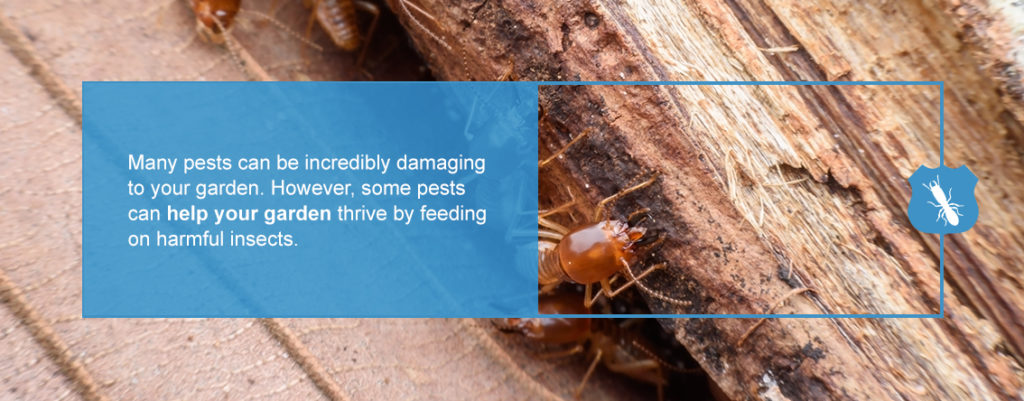
Many pests can be incredibly damaging to your garden. However, some pests can help your garden thrive by feeding on harmful insects. Knowing the difference between destructive and helpful pests is essential for the health of your plants.
These are examples of common pests found in New York that can harm or help your garden:
Pests That Can Harm Your Garden
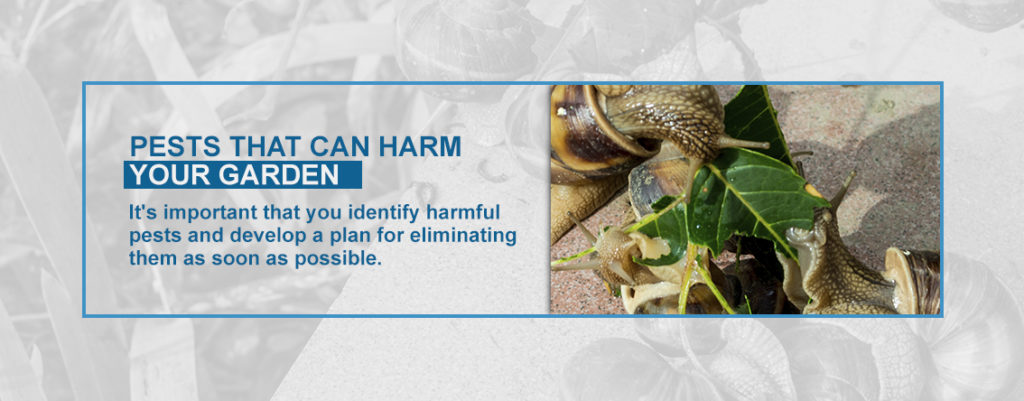
Harmful pests are those that feed on the roots, leaves or flowering parts of your garden produce. It’s important that you identify harmful pests and develop a plan for eliminating them as soon as possible. Otherwise, they might multiply quickly and spread to other parts of your garden.
The following insects are known to harm gardens:
- Aphids
- Termites
- Flies
- Mealybugs
- Hornworms
- Slugs
- Earwigs
- Stink bugs
- Grasshoppers
- Caterpillars
- Mosquitoes
Insects aren’t the only type of pest to be concerned about — small wildlife can also wreak havoc on your garden. Watch out for the following pests:
- Rabbits
- Raccoons
- Chipmunks
- Rats
- Mice
Though some of these creatures are cute to look at, they can eat your fruits and vegetables and tunnel through vulnerable root systems.
Pests That Can Help Your Garden
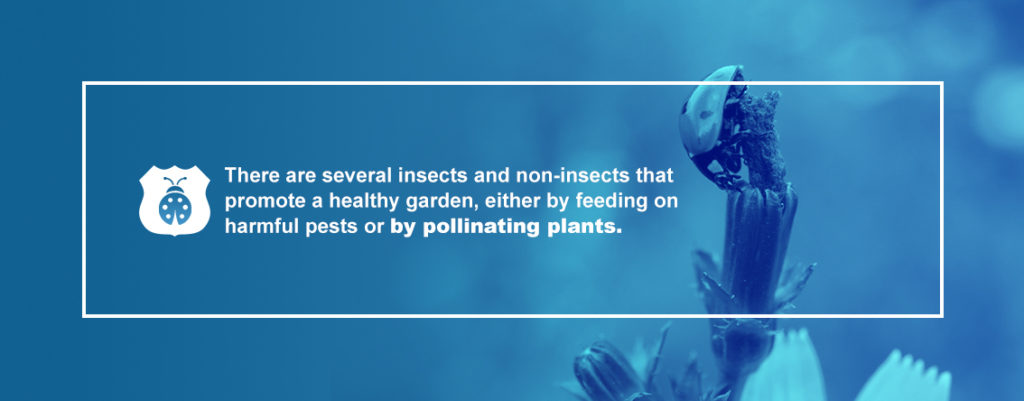
There are several insects and non-insects that promote a healthy garden, either by feeding on harmful pests or by pollinating plants. Attracting these helpers is one of the best methods for preventing pests in a garden.
If you see the following insects in your garden, don’t panic — they are your main line of defense against harmful predators:
- Ladybugs
- Bumblebees
- Praying mantises
- Green lacewings
- Wasps
- Damsel bugs
- Dragonflies
Some non-insects are equally beneficial, including
- Toads
- Spiders
- Garter snakes
- Bats
- Salamanders
- Turtles
- Lizards
Of course, an excess of helpful pests can become a problem if they infiltrate your house or outdoor structures. If this happens, consult a pest management company about developing an effective control strategy.
Pests That Can Be Either Harmful or Helpful
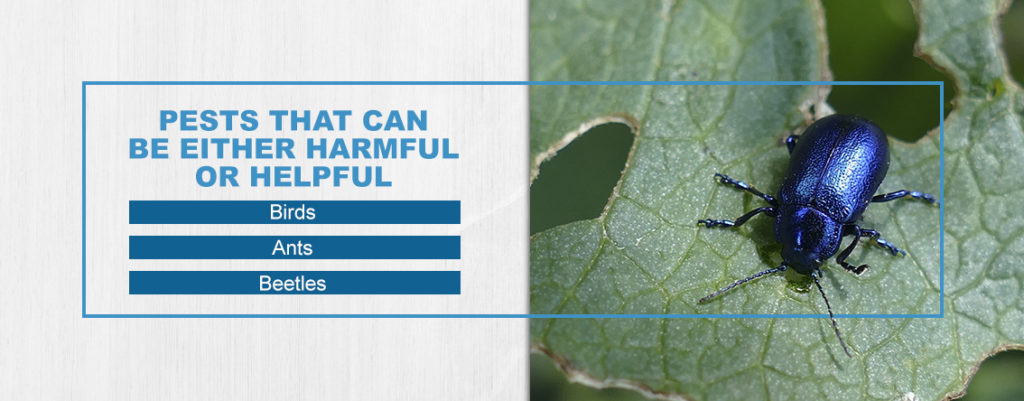
The following creatures are types of pests that can either harm or help your garden, depending on the specific breed or circumstance:
- Birds: Many birds, including songbirds, can be helpful around your garden, as they feed on problematic pests like worms or rodents. They are also natural pollinators. Birds of prey, including owls and hawks, are also beneficial for this reason. Other birds, like finches, may feed on your plants.
- Ants: Ants help control harmful pests and they are great garden pollinators. They even aerate garden soil, which promotes healthy growth. Unfortunately, these benefits come with a few drawbacks. Ants attract other pests, including aphids. Some ants also have painful bites and may enter your home.
- Beetles: Flea beetles and Japanese beetles are two insect types that feed on the leaves, fruit or flowers of a plant. Ground beetles, on the other hand, feed on harmful slugs and caterpillars.
Garden Plants That Attract Harmful Pests
One of the most effective ways to keep pests from eating vegetables, fruits and flowers from your garden is to avoid introducing plants that attract those pests in the first place. Plants attract pests in two ways: by acting as a source of food or shelter for an invading insect or by attracting bugs that harmful pests feed on. If you have a pest problem, it’s a good idea to take a closer look at what you’re growing.
The following are common plants that attract pests who can damage your home and garden:
- Fruit or nut producers, like walnut and apple trees
- Berry bushes
- Cauliflower
- Roses
- Young cucumbers
- Tomatoes
- Strawberries
- Carrots
- Leeks
- Mustard
- Onions
- Sweet corn
- Potatoes
- Flowering pumpkins
- Turnips
- Cabbage
- Peppers
- Four o’clock flowers
- Nasturtium
Many of the plants that are popular among pests are also beloved by gardeners. Farmers, for instance, do not stop growing sweet corn and carrots, despite the fact they attract raccoons and rabbits. If you plan to grow and harvest pest-attracting plants, take the necessary steps to keep them safe. Many gardeners utilize one or more pest-attracting plants in a concentrated area to attract and then trap damaging insects and wildlife.
Pests and Gardening: Companion Planting
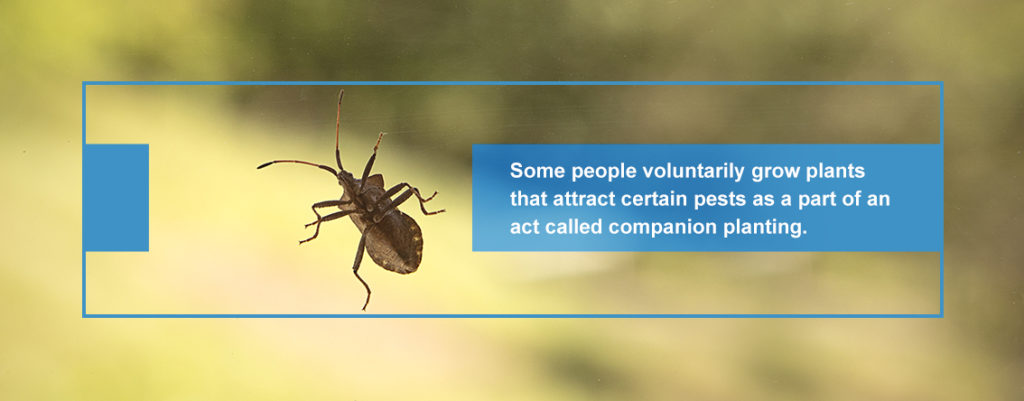
Some people voluntarily grow plants that attract certain pests as a part of an act called companion planting. The idea behind this method is to grow plants that either repel damaging pests or attract beneficial ones, therefore protecting the more vulnerable plants in your garden and enhancing growth conditions.
Garden Plants That Attract Helpful Pests
Helpful pests protect your garden by feeding on bugs that may eat your fruits, flowers, and vegetables. Think of these plants as a form of passive pest management, and introduce them to your garden to prevent and help control insect invasions.
These garden plants that attract pests can be very helpful for your garden:
- Baby’s breath
- Goldenrod
- Dill
- Yarrow
- Rue
- Daisies
- Chamomile
- Queen Anne’s lace
- Sunflowers
- Lavender
- Dahlias
- Parsley
- Sweet alyssum
- Marigolds
- Thyme
In addition to growing these plants, you also need to make the surrounding area inviting for helpful insects. Implement plenty of shaded shelter for insects to their lay eggs. Growing a variety of plants to appeal to multiple beneficial insects is also important. For example, ground beetles prefer low-lying plant environments, like ground-covering herbs and shrubs, while wasps prefer umbrella-shaped plants with small flowers.
Garden Plants That Repel Pests
Many plants produce strong odors and oils that deter pests from entering your garden. To keep pests from eating fruits, vegetables and flowers, try growing repellent plants near any plants that attract pests. This can help create a balance in your garden.
Some plants that repel damaging pests include:
- Catnip
- Garlic
- Marigolds
- Spearmint
- Eucalyptus
- Thyme
- Peppermint
- Basil
- Tansy
- Chives
- Coriander
- Oregano
- Wormwood
- Lavender
- Petunias
- Fennel
- Rosemary
- Borage
- Citronella
- Chrysanthemums
The trend among plants that repel damaging pests is that most of them are strongly aromatic. Plant aromatic herbs among your garden vegetables or flower beds to keep insects like aphids, flea beetles, and ants away. You’ll also notice that several plants — such as thyme, mint, and marigolds — can both repel damaging insects and attract helpful ones.
Signs a Pest Has Invaded Your Garden
Large pests like rodents and raccoons are easier to detect than insects. You can usually find animal tracks or entry holes where wildlife has entered your garden. While some insects are visible on the stems and leaves of garden plants, they are not always possible to detect. This means they can multiply quickly and consume your product or flowers before you have time to stop the spread.
To combat undetected insect growth, perform regular inspections of your plants. Use a flashlight to analyze the surrounding soil for any movement. Use a magnifying glass to get a close look at stems, the undersides of leaves, flower petals and the flesh of fruits or vegetables.
You can also look for the following signs, which could indicate a pest infestation:
- Holes and tears: Tiny holes and tears in the leaves, petals, and flesh of your plants are one of the best indicators that pests are present. Different pests leave various holes and tears behind. For example, grasshoppers consume the majority of the leaf, leaving only the vein skeleton behind, while other bugs leave small, circular holes.
- Wilting or decay: Bugs cause plants to wilt by laying eggs on the leaves, dragging the plant down and causing leaves to fall. Large pests like chipmunks and rabbits cause wilt and decay when they trample across gardens while on the hunt for food to scavenge.
- Discoloration: If the once-green leaves of your garden plants or flowers have started to yellow, it could be a sign of viral, fungal or bacterial plant disease. Pests can transfer these diseases to your plants, and many of them are contagious between plants.
- Foreign substance: Several insects secrete a thick, sticky substance known as honeydew. Honeydew is made of sugar, which insects produce naturally after consuming sap from plants. Aphids are the largest culprit, but several other sap-ingesting insects produce it as well. Other residues, such as white powder or mold, could indicate plant sickness caused by pests or nutritional deficiencies.
The presence of these infestation signs does not always signify pests. In fact, many infestation signs are also indicators of possible disease or nutrient deficiencies. Tracking symptoms is the best way to rule out other possibilities. Keep a small notebook and record the date, symptom and plant affected. After each daily or weekly inspection, note any changes in the plant. You could also consider having your soil professionally tested and consulting with an agricultural expert or botanist with specific plant-related concerns.
How to Protect a Garden From Pests
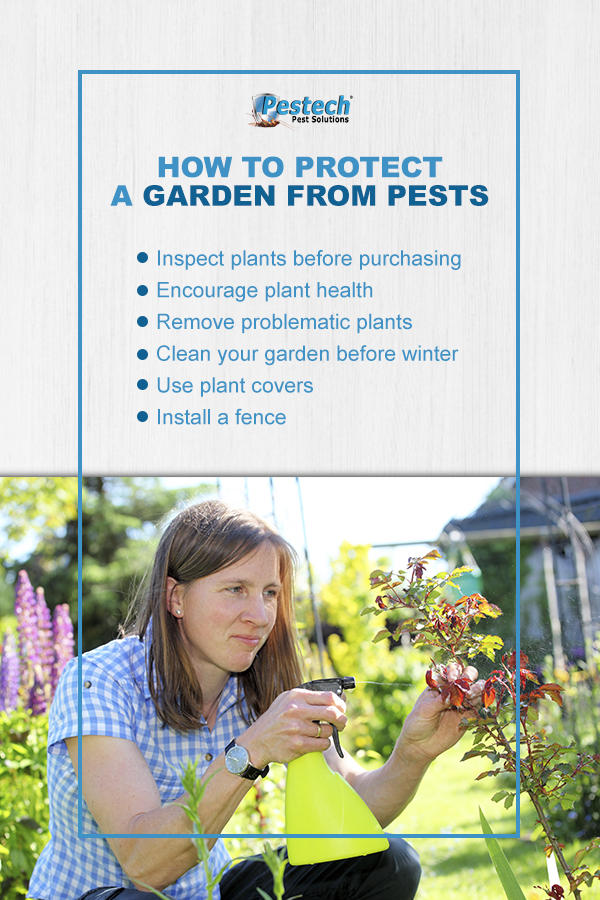
In addition to knowing how to identify a pest infestation, you need to know how to keep your plants safe from future problems. While companion planting to repel harmful insects and attract beneficial ones is an excellent strategy, it is not the only option.
Here is how to prevent pests in a garden:
- Inspect plants before purchasing: If you’re bringing your plants home from a nursery, take care to inspect the plant before buying it. First, take a look at your surroundings. Are the plants in the greenhouse thriving and well cared for? The presence of several wilted or dead plants could indicate a lack of proper care. Then, analyze your plant’s foliage, shape, soil, root system and root ball, buds and flowers. Be thorough in your inspection — many pests are skilled at hiding.
- Encourage plant health: Weak or sick plants are far more susceptible to pest infestations than healthy ones. Follow proper planting procedures for your garden plants and flowers. Do not place plants too close to one another and rotate crops often. When necessary, use mulch and fertilizer to aid in growth. Weed your garden regularly and cover sensitive plants during extreme temperatures or frost.
- Remove problematic plants: As we’ve covered, certain pests can transmit diseases to your garden produce or flowers. Many of these diseases are contagious and can spread quickly throughout your garden. To minimize this risk, you must remove and dispose of problematic plants as soon as possible. You should do the same with any rotten or fallen fruits or vegetables, as they can attract harmful insects and wildlife.
- Clean your garden before winter: Keep a clean garden to minimize the number of places pests and rodents can hide. Promptly remove sticks, old mulch, debris, weeds, and dead plants. This is especially important to do in the fall before the winter freeze, so pests do not spend the winter making a home in your garden soil. One way to do this is rough tilling just after the season ends to shift the dirt enough to expose any insects to the impending cold temperatures.
- Use plant covers: If you live in an area that is especially prone to insects or wildlife infestation, use plant covers whenever necessary. Some plant cover options include cloches, plant collars, and plant netting. Be sure whichever covering method you use is appropriate for plants and permits an adequate level of airflow, sunlight, and pollination access. Plant covers are particularly useful against birds, which are one of the most challenging garden pests to manage.
- Install a fence: Build a fence around the perimeter of your garden or flower bed to keep large pests away, like squirrels, rabbits, and raccoons. A small mesh fence is typically enough to keep smaller animals out, but you’ll need a taller, sturdier structure if you want to keep deer out.
Tips for Treating Pests From Your Garden
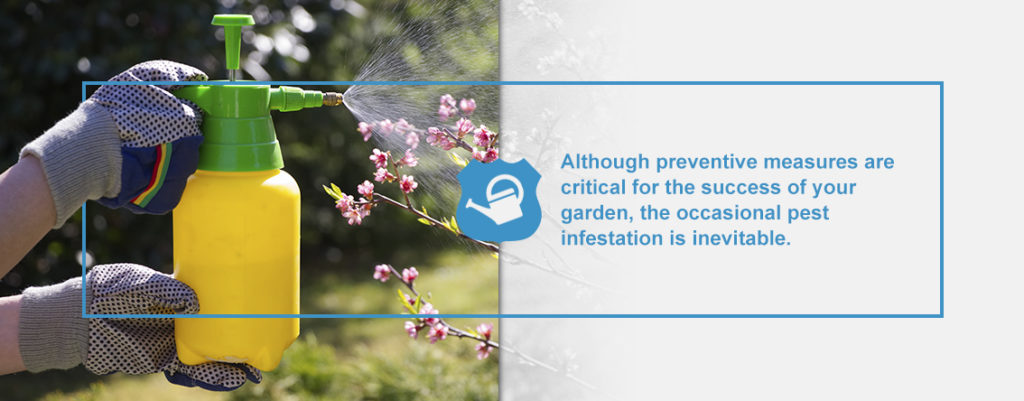
Although preventive measures are critical for the success of your garden, the occasional pest infestation is inevitable. If you have discovered pests in your garden, there are a few steps you can take to manage the situation before too much damage occurs:
- Do your homework: There are a few tips and tricks for removing specific types of pests from your garden. Research your invader. What kind of environment does it thrive in? What are its weaknesses? What treatment options are available? For example, caterpillars are very susceptible to neem oil, and metal is very effective for keeping slugs at bay.
- Hand-pick large bugs: Although it is far from a permanent solution, hand-picking large bugs from your garden produce or flowers is a quick way to minimize and prevent any damage. When removing insects or wildlife from your garden, take adequate safety measures to protect yourself, including gloves. Never attempt to move or eradicate dangerous pests on your own — that’s what professionals are for.
- Wash plants with a gentle solution: Believe it or not, sometimes a good bath is a trick to remove pests from your plants temporarily. Create a water-based bath for your plants and apply it using a spray bottle or watering can. There are several different solutions you can create at home, including water and dish soap, water and pepper, water and baking soda with vinegar, water with milk and dish soap and more. For some bugs like aphids, a splash of cold water is enough to deter them.
- Contact a professional pest control service: Sometimes, a pest invasion is too much to eradicate on your own. In this case, it may be wise to call a professional pest treatment company. These professionals are trained to identify and understand the source of the problem, as well as to develop and implement a safe and effective treatment strategy.
Have a Pest Problem? Pestech Pest Solutions Can Help.
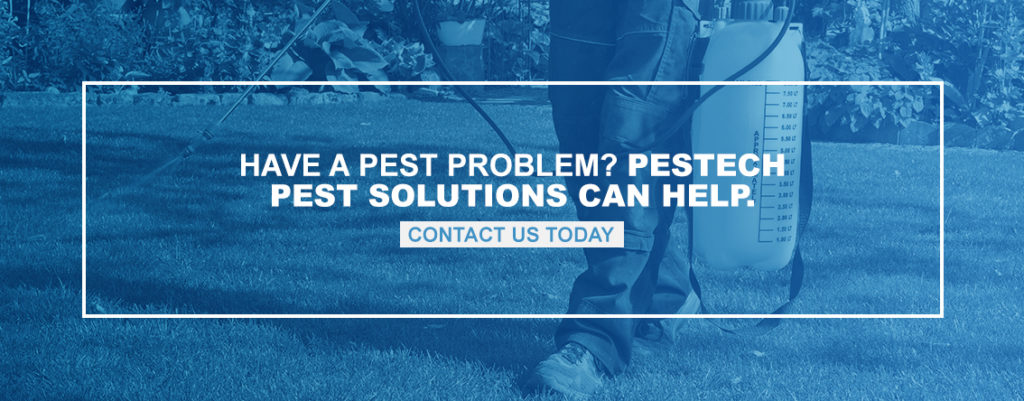
While many pests can be good for your garden, harmful insects and wildlife can consume and destroy your hard work. In addition, your garden might give bugs or rodents easy access to your home, where they become a threat to you, your family, your pets, and your property. Through strategic companion planting and thoughtful preventive practices, you can slow or stop future infestations from taking place.
If you have a pest problem in your garden, let the experts at Pestech Pest Solutions help you manage it. We are a proudly family-owned business that has been keeping pests in line since 1989. We specialize in helping both residential and commercial property owners take control of their land. We can inspect your property for signs of an infestation, help you identify the root of the problem, and develop a long-term management solution. This includes monthly or quarterly visits and regular check-ins. We will help educate you on the basics of pest management and the best methods for managing common New York pests, like rodents, termites, ticks, flies, mosquitoes, bats, bed bugs, birds, stink bugs and fleas. We can also assist with larger pests, including raccoons.
A thriving, healthy garden is something to be proud of, and we want to help you protect it. To schedule your pest inspection or learn more about the services we offer, contact a Pestech representative today to schedule your pest inspection in Orange County, Dutchess County and throughout New York.
